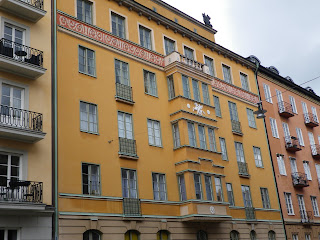Swedish cuisine is often maligned as being absurd and unpalatable, for instance pickled herring. Before I arrived, one subject I was decidedly not excited about was the food. I had Swedish food occasionally in North America, and I could not tolerate their desire to make things that are not naturally fish-flavored to taste like fish. (Anchovy-flavored potatoes were particularly traumatic.)
However, my mind was completely changed when I went to my first Swedish grocery store and saw entire aisles of cookies and candies that I had never eaten before! It is my responsibility to explore the world of Swedish sweets, and dutifully report their quality.

It is Swedish custom to eat cookies everyday in a ritual called "Fika." It involves drinking lots of coffee (always free refills in Sweden) and eating little cookies. Above, I have pepparkakor and punschrullar. Pepparkakor are the brown cookies, and are a Swedish version of gingerbread. They are very crisp and spicy, heavy on cloves, nutmeg and cardamom. Cardamom is a very popular flavor in Swedish cooking, which surprised me because I had only ever had it in Indian food before. The funny green things are punschrullar, which translate to mean "punch rolls," but another name translate to mean vacuum cleaner, because they look like the head of an old Electrolux. The punschrullar is an unusual cookie. It is covered in green marzipan and dipped in chocolate. Inside there is a spongey cake that is soaked in liqueur. The liqueur flavor reminded me of rum, but it's much more exotic than that. It is "arrack" flavor, an exotic Asian liqueur made from palm trees. It is a very heady flavor.

Swedish candy is entirely unique from that of North America, and follows two consistent themes, raspberry (hallon in Swedish) and licorice (lakrits in Swedish). Many candies combine these flavors too. Saltlakrits is the most popular candy, it is an intensely salty licorice that is an acquired taste. I've grown to love the saltlakrits because it offers a very complicated flavor. Different candies are more or less salty, and an unsalted licorice is usually called "English licorice." The small red and black discs are quite strange, being raspberry, licorice, salted, and sour flavored. Swedes are often surprised when I tell them we don't have salted candy in North America, but I can't see it ever being very popular outside of Europe.

Being Sweden, fish is very popular. Above is "knackebrod med smor-mjolk, gravad lax, och kaviar," or a cracker with cream cheese, smoked salmon, and caviar. Caviar is fairly ubiquitous in many forms. Swedes particularly like tube caviar, which has a toothpaste-y consistency. I prefer the jarred caviar, which is very inexpensive (about four US dollars a jar.) Caviar is considered a staple, rather than a luxury. Before I feel too decadent, I should mention that a friend told me much of the caviar is dyed to be black, to make it seem like Russian caviar, and that Swedish caviar is actually of very poor quality. Whatever, I feel very fancy eating caviar on everything.

Another popular food in Sweden are fish salads. This is a shrimp and crab salad, pre-prepared and sold in a package. It's quite heavy on the mayonnaise (Swedes love mayonnaise like Southerners do.) There are dozens of different seafood salads, with shrimp, herring, tuna, oysters, etc. Also, the usually sell shrimp with the heads on here, which is a little gross.
And yes they eat meatballs here, but really they deserve their own discussion, to come at a later date.

















